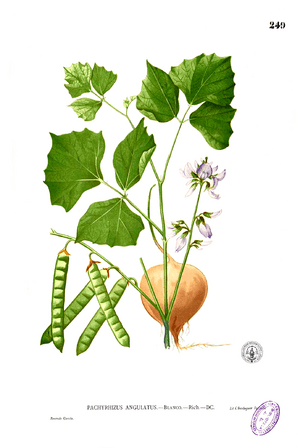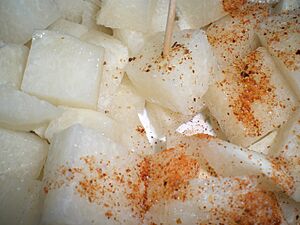Jícama facts for kids
Quick facts for kids Jícama |
|
|---|---|
 |
|
| Scientific classification | |
| Kingdom: | |
| (unranked): | |
| (unranked): | |
| (unranked): | |
| Order: | |
| Family: | |
| Genus: | |
| Species: |
P. erosus
|
| Binomial name | |
| Pachyrhizus erosus (L.) Urb.
|
|
Jícama is a cool plant from Mexico and Central America. It's known by many names like jícama, Mexican yam bean, or Mexican turnip. While it's a vine, most people know jícama for its yummy, edible root. This root is a tuber, which means it grows underground.
Jícama belongs to the Pachyrhizus plant family, which is also called the bean family (Fabaceae). Other plants in this family are often called "yam beans." There are a few different types of yam beans grown for food. The most common one you'll find is Pachyrhizus erosus.
Jícama plants grow pretty flowers, which can be blue or white. They also produce pods that look a bit like lima beans. There are two main kinds of P. erosus grown. One is called jicama de agua and the other is jicama de leche. The agua type has a watery, clear juice and is the one most often sold. The leche type has milky juice and a longer root.
Contents
What is Jícama?
Jícama has many other fun names. Some people call it Mexican potato, Chinese potato, or sweet turnip. In some places like Ecuador and Peru, the name jícama is used for a different plant called yacón. Yacón also has edible tubers, but it's not related to the jícama we're talking about.
How Jícama Grows
The jícama vine can grow very tall, sometimes up to 4 or 5 meters (about 13 to 16 feet) if it has something to climb on. Its root can get really big too! Some roots can be 2 meters (about 6.5 feet) long and weigh up to 20 kilograms (about 44 pounds). The biggest jícama root ever found weighed 23 kilograms (50 pounds) in the Philippines in 2010.
Jícama plants don't like cold weather. They need at least nine months without frost to grow big roots. If you live in a cooler area, you can still grow them, but the roots might be smaller. For the best growth, seeds should be started indoors in a warm place. This plant grows best in tropical areas where it's warm all year.
History of Jícama
Jícama first came from Mexico and Central America. People have found jícama at old archaeological sites in Peru. This shows that people were eating it as far back as 3000 BC! In the 1600s, people from Spain brought jícama from Mexico to Asia. This is how it started to spread around the world.
Cooking with Jícama

The outside of the jícama root is yellow and thin like paper. But the inside is a creamy white color. It has a super crisp texture, a bit like a raw potato or a pear. Its taste is sweet and starchy, similar to some apples or raw green beans.
Most people eat jícama raw. You can sprinkle it with salt, lemon, or lime juice, and even chili powder for a spicy kick. It's also used in soups and stir-fried dishes. Jícama tastes great with things like chili powder, cilantro, ginger, lemon, lime, orange, red onion, salsa, sesame oil, grilled fish, and soy sauce. You can cut it into thin slices and dip them in salsa.
In Mexico, jícama is popular in salads, fruit mixes, and other cooked meals.
Important Safety Note
It's important to know that while the root of the jícama plant is safe to eat, other parts of the plant are not. The seeds, for example, contain a natural substance called rotenone, which can be harmful if eaten. This substance is sometimes used to control insects or fish. However, the outside of the seed pods can be cooked and eaten in some dishes, like the "Bunga ng singkamas" stew in the Philippines.
Jícama Around Asia
| Nutritional value per 100 g (3.5 oz) | |
|---|---|
| Energy | 159 kJ (38 kcal) |
|
8.82 g
|
|
| Sugars | 1.8 g |
| Dietary fiber | 4.9 g |
|
0.09 g
|
|
|
Protein
|
0.72 g
|
| Vitamins | Quantity
%DV†
|
| Thiamine (B1) |
2%
0.02 mg |
| Riboflavin (B2) |
2%
0.029 mg |
| Niacin (B3) |
1%
0.2 mg |
| Pantothenic acid (B5) |
3%
0.135 mg |
| Vitamin B6 |
3%
0.042 mg |
| Folate (B9) |
3%
12 μg |
| Choline |
3%
13.6 mg |
| Vitamin C |
24%
20.2 mg |
| Minerals | Quantity
%DV†
|
| Calcium |
1%
12 mg |
| Iron |
5%
0.6 mg |
| Magnesium |
3%
12 mg |
| Manganese |
3%
0.06 mg |
| Phosphorus |
3%
18 mg |
| Potassium |
5%
150 mg |
| Sodium |
0%
4 mg |
| Zinc |
2%
0.16 mg |
|
Link to USDA Database entry
|
|
| †Percentages estimated using US recommendations for adults. | |
When the Spanish brought jícama to the Philippines, it became very popular there. In the Philippines, it's called singkamas. From there, it traveled to China and other parts of Southeast Asia.
In these regions, jícama is used in many dishes. You might find it in popiah (a fresh spring roll), bola-bola (meatballs), and fresh lumpia in the Philippines. It's also a common ingredient in salads like yusheng and rojak in Indonesia, Singapore, and Malaysia.
In the Philippines, people often eat fresh jícama with rice vinegar and salt, or with bagoong (shrimp paste). In Malay, it's called ubi sengkuang. In Indonesia, it's known as bengkuang. The city of Padang in West Sumatra is even called "the city of bengkuang" because it's grown so much there.
Jícama has many names in different languages across Asia. In Chinese, it can be dòushǔ or liáng shǔ. In Cantonese, it's sa1 got. In Vietnamese, it's cây củ đậu or củ sắn. In Myanmar, it's sane-saar-u. In Thai, it's man kaeo. In Cambodia, it's dɑmlɔoŋ rəluəh. In Bengali, it's shankhalu, which means "conch potato" because of its shape. In Hindi, it's mishrikand. In Laos, it's man phao, which is a smaller, sweeter type. In Japan, it's sometimes called kuzu-imo or hikama.
Jícama Nutrition
Jícama is a healthy food! It has a lot of dietary fiber, especially a type called inulin. This inulin is a prebiotic, which means it helps good bacteria grow in your stomach. Jícama is mostly water (86–90%). It has very little fat and protein. It's also a good source of vitamin C, which helps keep you healthy.
Storing Jícama
To keep jícama fresh, you should store it in a dry place. The best temperature is between 12 and 16 degrees Celsius (53 and 60 degrees Fahrenheit). Don't put whole, unpeeled jícama roots in the refrigerator, because the cold can damage them. If stored correctly, a fresh jícama root can last for one or two months.
See also
 In Spanish: Jícama para niños
In Spanish: Jícama para niños



